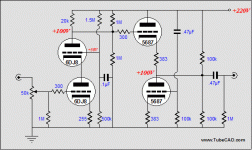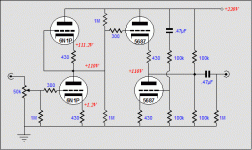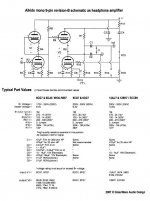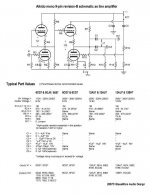Do you have the latest Aikido manual of John Broskie (Aikido_Mono 9-Pin rev. B.pdf)?
It contains a table of all the possible tubes and operating conditions...
Though the table doesn't list the 6N6P looking at the datasheet the 6N6P should be happy with the same B+ (200-220V) and a slightly smaller cathode resistor (~220R).
Btw. The schematic you attached seems to be an older one that differs from the one used in the PCB's. The manual contains the latest schematic plus what I mentioned before. I built my Aikido headphone amplifier according to the manual (using 6CG7/6H30).
best, O.
It contains a table of all the possible tubes and operating conditions...
Though the table doesn't list the 6N6P looking at the datasheet the 6N6P should be happy with the same B+ (200-220V) and a slightly smaller cathode resistor (~220R).
Btw. The schematic you attached seems to be an older one that differs from the one used in the PCB's. The manual contains the latest schematic plus what I mentioned before. I built my Aikido headphone amplifier according to the manual (using 6CG7/6H30).
best, O.
The schematic I posted is from Http://www.tubecad.com/2004/blog0011.htm
Schematic I thought I posted
Schematic I thought I posted
Attachments
From post #96
back from holiday
i have been using 6n6p in aikido pre
built as per JB specs for 6n1p into 5687
430R cathode resistors 220V HT
with no problems at all
6n1p had arrived when i got home
so i put two in first stage
measures good and sounds better
must be your 6n6p tha problem
how's it going now?
*****************************
So, are you telling me that all I need to do is rewire the 2nd position to accept the 6N6P and its a go?
back from holiday
i have been using 6n6p in aikido pre
built as per JB specs for 6n1p into 5687
430R cathode resistors 220V HT
with no problems at all
6n1p had arrived when i got home
so i put two in first stage
measures good and sounds better
must be your 6n6p tha problem
how's it going now?
*****************************
So, are you telling me that all I need to do is rewire the 2nd position to accept the 6N6P and its a go?
Post #4 is the schematic I used. I posted the wrong schematic in my post #1.
Quote:
The schematic of post 1 is the cascode version of the Aikido, due to the high gain probably not suited as a line stage. Note that the PS noise is not attenuated (just a 0.47uF and 100k resistor at the bottom 5687) as the cascode has very low PSRR.
I've been using it since it was first put on the blog and have had no problems with it. It has a lot of gain so I turn the input control down.
I guess I should have mentioned that I have several of the boards from the group buy that Bas had.
Quote:
The schematic of post 1 is the cascode version of the Aikido, due to the high gain probably not suited as a line stage. Note that the PS noise is not attenuated (just a 0.47uF and 100k resistor at the bottom 5687) as the cascode has very low PSRR.
I've been using it since it was first put on the blog and have had no problems with it. It has a lot of gain so I turn the input control down.
I guess I should have mentioned that I have several of the boards from the group buy that Bas had.
I guess I should have mentioned that I have several of the boards from the group buy that Bas had.
Then go for it and try it out...
Andypairo didn't disclose his cathode resistor values, but 220ohm should run them at about 13mA when my math is correct.
Stixx said:
Then go for it and try it out...
Andypairo didn't disclose his cathode resistor values, but 220ohm should run them at about 13mA when my math is correct.
Yes the 220 Ohm figure is right. I also tried 110 Ohm but didn't notice any improvement.
Ciao
Andrea
burnedfingers said:
I've been using it since it was first put on the blog and have had no problems with it. It has a lot of gain so I turn the input control down.
With modern sources as CD players usually a unity gain buffer is enough. That's why I use my Aikido as front-end for my hybrid amp followed by a power diamond buffer.
Ciao
Andrea
Heather current
STIXX
I measured AC current in my Aikido stage and was very suprised of the result: 4,2 A (AC)!!!
I use 6N6P in both position. I know that 6N6P is a "thirsty" tube.
The datasheet says 750 mA /+-10 %, but 4200mA, wow.
The input tubes running a little bit harder than the second stage
(Rk= 220 ohm and 430 ohm). B+ = 200 V DC (Bas powersupply)
I use AC heather with 12,6 V from a Hammond 266L 12 (6,3 V/5 A
and 12,6 V/2,5 A ). Very hot, I can not put my finger on it.
I always had an idea that connecting the heathers in series reduce the current one half of the needs in parallel??
(I assume the heathers are in series, I use J1 for input tubes and J4 for the second)
I expected a current of ca. 400 mAx4= 1600 mA, so what is wrong??
The stage plays very well, nothing wrong at all with the sound quality.
Regards
Eivind Stillingen, Norway
STIXX
I measured AC current in my Aikido stage and was very suprised of the result: 4,2 A (AC)!!!
I use 6N6P in both position. I know that 6N6P is a "thirsty" tube.
The datasheet says 750 mA /+-10 %, but 4200mA, wow.
The input tubes running a little bit harder than the second stage
(Rk= 220 ohm and 430 ohm). B+ = 200 V DC (Bas powersupply)
I use AC heather with 12,6 V from a Hammond 266L 12 (6,3 V/5 A
and 12,6 V/2,5 A ). Very hot, I can not put my finger on it.
I always had an idea that connecting the heathers in series reduce the current one half of the needs in parallel??
(I assume the heathers are in series, I use J1 for input tubes and J4 for the second)
I expected a current of ca. 400 mAx4= 1600 mA, so what is wrong??
The stage plays very well, nothing wrong at all with the sound quality.
Regards
Eivind Stillingen, Norway
I expected a current of ca. 400 mAx4= 1600 mA, so what is wrong??
Well, when the datasheet says 750mA it should rather be
750 x4 = 3A (+10% ?= 3.3A)... 4.2 A is still quite high.
How did you measure that number?
In an Aikido it is usually the other way round with the output tubes run harder...?The input tubes running a little bit harder than the second stage
I always had an idea that connecting the heathers in series reduce the current one half of the needs in parallel??
As far as I know you cannot heat the 6N6P with 12.6V since it has 6.3V heaters... ?? I am no expert so maybe somebody else can clarify.
Heather current in Aikido
When I built a Lampizator stereostage with 2x6N6P, I connected pin 4 and 5 on the two tubes in series from a 12 V power supply. This was according to what Lukasz recommended.
One half of 800 mA =400 mA. This is how I thought and what I exspected to measure. Four tubes x 400mA = 1600mA
How I measured 4200 mA?
I split one of the twisted leaders from Hammond 166L12, connected my multimeter in series and used the AC range for the current.
Anyone else that feel free to comment my questions?
Rergards
Eivind Stillingen, Norway
When I built a Lampizator stereostage with 2x6N6P, I connected pin 4 and 5 on the two tubes in series from a 12 V power supply. This was according to what Lukasz recommended.
One half of 800 mA =400 mA. This is how I thought and what I exspected to measure. Four tubes x 400mA = 1600mA
How I measured 4200 mA?
I split one of the twisted leaders from Hammond 166L12, connected my multimeter in series and used the AC range for the current.
Anyone else that feel free to comment my questions?
Rergards
Eivind Stillingen, Norway
Hi Eivind
Each 6N6P consumes 6,3V and about 800mA. If you connect two in series this chain will consume 12,6V and 800mA. The correct way to put the heaters in series is connecting pin 4 of one valve to pin 5 of the other valve, and the 12,6V of the transformer across the pins left. It is just like the old christmas lights: if you pull one out, or one burns, the whole chain shuts down.
You can connect two chains in parallel. You keep the same 12,6V, but the second chain will draw an additional 800mA, so a total of 12,6V and 1600mA is drawn from your transformer.
If your circuit is drawing 4200mA of the transformer it means the current is more than twice what is actually needed. Therefore I think that you may have connected the 12,6V across each 6N6P. The higher voltage will make the valve consume more current, more than 1A each in your case. Still, well, I would think that with 12,6V across the 6N6P it would pull way more than 1A...
Are you sure there are no wiring mistakes? Isn't there a rectifier being fed from the same filament? Do all 6N6P's lite up equally, or is there a 'brigther' one among them?
Hope this helps, Erik
Each 6N6P consumes 6,3V and about 800mA. If you connect two in series this chain will consume 12,6V and 800mA. The correct way to put the heaters in series is connecting pin 4 of one valve to pin 5 of the other valve, and the 12,6V of the transformer across the pins left. It is just like the old christmas lights: if you pull one out, or one burns, the whole chain shuts down.
You can connect two chains in parallel. You keep the same 12,6V, but the second chain will draw an additional 800mA, so a total of 12,6V and 1600mA is drawn from your transformer.
If your circuit is drawing 4200mA of the transformer it means the current is more than twice what is actually needed. Therefore I think that you may have connected the 12,6V across each 6N6P. The higher voltage will make the valve consume more current, more than 1A each in your case. Still, well, I would think that with 12,6V across the 6N6P it would pull way more than 1A...
Are you sure there are no wiring mistakes? Isn't there a rectifier being fed from the same filament? Do all 6N6P's lite up equally, or is there a 'brigther' one among them?
Hope this helps, Erik
ErikdeBest
Erik, you were right. I have misunderstood the "Filament Jumper Wire Schedule" that John has written.
Both voltage and current for heaters was wrong. Now it is right: 6,3 V on pin 4 and 5 and a current of 3 A for all four 6N6P. Everything works fine and sound very well.
But I am suprised that all 6N6P after the "shock" of being fed by almost double voltage and a current of more than 1 A each are still alive. This tube must be a "tough guy". Do you think I will run into problems keeping them in their sockets, or will I risk a sudden death very soon.
They have not played more than a couple of hours all together under the wrong conditions.
The 266L12 tranformers that I use is a CT 12,6 V. For Aikido I use only one of the 0-6,3 V pair. The second 0-6,3 V pair, I use for the power board (Bas). The Hammond data says 2,5 A, but my four 6N6P need as you can see, 3 A. Now I can easily hold my finger on the transformer, not very hot.
A current of 0,5 A more (+20%) then the specifications, is it ok, or do I need a bigger transformer?
Regards
Eivind Stillingen
Erik, you were right. I have misunderstood the "Filament Jumper Wire Schedule" that John has written.
Both voltage and current for heaters was wrong. Now it is right: 6,3 V on pin 4 and 5 and a current of 3 A for all four 6N6P. Everything works fine and sound very well.
But I am suprised that all 6N6P after the "shock" of being fed by almost double voltage and a current of more than 1 A each are still alive. This tube must be a "tough guy". Do you think I will run into problems keeping them in their sockets, or will I risk a sudden death very soon.
They have not played more than a couple of hours all together under the wrong conditions.
The 266L12 tranformers that I use is a CT 12,6 V. For Aikido I use only one of the 0-6,3 V pair. The second 0-6,3 V pair, I use for the power board (Bas). The Hammond data says 2,5 A, but my four 6N6P need as you can see, 3 A. Now I can easily hold my finger on the transformer, not very hot.
A current of 0,5 A more (+20%) then the specifications, is it ok, or do I need a bigger transformer?
Regards
Eivind Stillingen
Hi Eivind
Glad it worked out for you! As to the lifetime of the 6N6Ps after the higher voltage on the filaments... I do not know what the exact consequences are. It is possible that the valves will have a lower lifetime, but I do not think they will suffer a sudden death. To be sure you will not stay without music I would recommend you to have some spares handy: the 6N6P's aren't that expensive (yet)...
About the 20% extra current drawn from the transformer. If I understand it right you are loading one side of the winding with a 20% extra, while the other side is loaded with 1A or something for the rectifier? You say that the transformer does not heat up excessively, and you are probably not experiencing hum or rattling from it, so I would not worry.
Enjoy the music!
Erik
Glad it worked out for you! As to the lifetime of the 6N6Ps after the higher voltage on the filaments... I do not know what the exact consequences are. It is possible that the valves will have a lower lifetime, but I do not think they will suffer a sudden death. To be sure you will not stay without music I would recommend you to have some spares handy: the 6N6P's aren't that expensive (yet)...
About the 20% extra current drawn from the transformer. If I understand it right you are loading one side of the winding with a 20% extra, while the other side is loaded with 1A or something for the rectifier? You say that the transformer does not heat up excessively, and you are probably not experiencing hum or rattling from it, so I would not worry.
Enjoy the music!
Erik
- Status
- This old topic is closed. If you want to reopen this topic, contact a moderator using the "Report Post" button.
- Home
- Amplifiers
- Tubes / Valves
- 6N6P in an Aikido?



